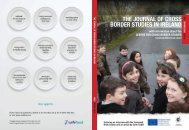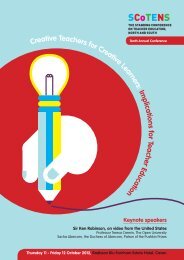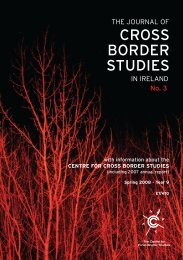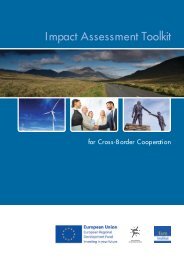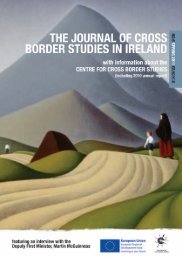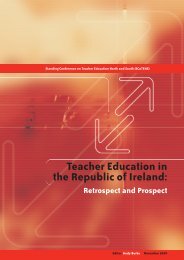improving government service delivery to minority ethnic ... - NCCRI
improving government service delivery to minority ethnic ... - NCCRI
improving government service delivery to minority ethnic ... - NCCRI
Create successful ePaper yourself
Turn your PDF publications into a flip-book with our unique Google optimized e-Paper software.
(continued from previous page)<br />
The Department of Justice, Equality and Law Reform released some data on the outcome of the first<br />
recruitment campaign after these changes were introduced in 2005. 229 The data showed that a <strong>to</strong>tal of 8,462<br />
people applied. 6,890, or 81 per cent, completed a voluntary survey in which they indicated their <strong>ethnic</strong>ity.<br />
Some 5,573 candidates classified themselves as “white Irish”. Of these, 4,066 sat the aptitude test with 2,679,<br />
or 66 per cent, passing, making them eligible for the interview stage. The largest <strong>ethnic</strong> <strong>minority</strong> group was<br />
the “Asian Chinese” community, represented by 602 applicants. Of these 463 sat the aptitude test with 101,<br />
or 22 per cent, progressing <strong>to</strong> interview. 348 candidates described themselves as “white other”, meaning they<br />
are white but not Irish. Of these, 146 sat the aptitude test with 57, or 39 per cent, passing and progressing<br />
<strong>to</strong> the interview stage. 124 applicants described themselves as “black African”. Of these 45 turned up for the<br />
aptitude test with two, or 4 per cent, passing and progressing <strong>to</strong> the interview stage. Five applicants described<br />
themselves as “black other”, with four sitting the aptitude test and one progressing <strong>to</strong> the interview stage. The<br />
final <strong>ethnic</strong> category was “Asian other”, with 153 candidates. Of these, 76 presented for an aptitude test with<br />
10, or 13 per cent, proving successful and progressing <strong>to</strong> the interview stage.<br />
229_Conor Lally, Figures<br />
show <strong>ethnic</strong>ity of Garda<br />
candidates, Irish Times 8<br />
February 2006.<br />
The results suggest that a significant start has been made but significant statistical differences disparities<br />
between the success rates of the various <strong>minority</strong> groups require further investigation; language difficulties may<br />
be a fac<strong>to</strong>r.<br />
Benchmarking<br />
Benchmarking strategies comprise two components. In the first place, appropriate indica<strong>to</strong>rs provide the<br />
essential baseline data which can be used <strong>to</strong> measure the presence of <strong>minority</strong> <strong>ethnic</strong> groups in any particular<br />
sec<strong>to</strong>r as well as their levels of inclusion, socio-economic and cultural disadvantage, linguistic needs, and<br />
any other relevant issues. Secondly, such indica<strong>to</strong>rs should be used in the formulation of mainstreaming and<br />
targeting programmes in order <strong>to</strong> promote equality for such communities.<br />
For reasons which have already been explained, this is an area where much remains <strong>to</strong> be done in Ireland.<br />
Service provision for <strong>minority</strong> <strong>ethnic</strong> groups is not yet grounded in a system of formal evaluation, based on<br />
hard targets and agreed indica<strong>to</strong>rs, backed by statu<strong>to</strong>ry force. Irish <strong>service</strong> providers are still largely reliant on<br />
a complaints-driven approach in evaluating <strong>service</strong> provision. Such an approach necessarily conflicts with the<br />
notion of measurable outcomes based on objective indica<strong>to</strong>rs and time-related targets.<br />
This situation will undoubtedly change over time as the provisions of the NPAR are translated in<strong>to</strong> sec<strong>to</strong>ral<br />
audits and action programmes, based on the identification of appropriate targets, indica<strong>to</strong>rs, timelines and<br />
benchmarks. This process will requite a significant shift of in attitudes and forms of governance. In the case of<br />
an indigenous <strong>minority</strong>, the Traveller community, local authorities were required <strong>to</strong> adopt fixed targets for the<br />
provision of accommodation but some years after such provisions were put in place little action had been taken.<br />
The lack of indica<strong>to</strong>rs and basic data is a pressing issue in virtually all sec<strong>to</strong>rs. For example, the Gárda National<br />
Immigration Bureau have information on country of origin and immigration status but only immigrants from<br />
outside the EU are registered as such information is not required for EU residents. Gárda HQ stated when<br />
interviewed that the only information they collect is name, date of birth, gender, physical appearance and<br />
nationality. In the schools, there is at present no nationally collated data on <strong>ethnic</strong>ity at primary level and the<br />
information available is rudimentary and unsystematic. Although it has been estimated that an overall figure of<br />
approximately 6,000 pupils of non-Irish origin are enrolled in the primary system, this figure seems improbably<br />
low. Better data is available for second-level enrolment, where numbers are more modest and needs are<br />
arguably not as great. Within the employment sec<strong>to</strong>r, data is rudimentary and unsystematic.





